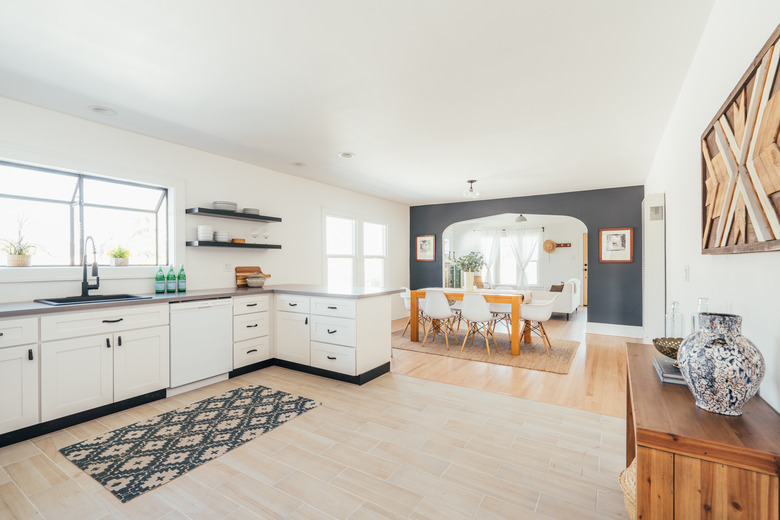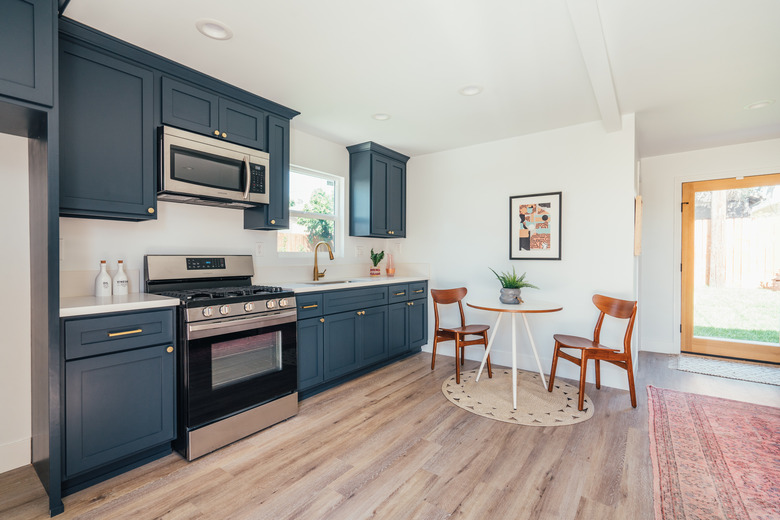Vinyl Flooring: What You Need To Know
It's easy to understand why vinyl flooring is a popular home flooring material: it's inexpensive, water- and stain-resistant, and super easy to clean. This makes it perfect for kitchens, bathrooms, laundry rooms, entryways—any areas with lots of traffic and moisture, including those below ground level. It's easy to install, and comes in thousands of designs.
Vinyl is categorized as a resilient flooring material—a category that also includes rubber flooring, EVA foam tile, PVC plastic tile, and linoleum. Many of these floorings have similar attributes—and similar installation methods—as true vinyl flooring. All of these resilient floorings compress and spring back so your steps have some bounce; this quality also makes them more comfortable to stand on than harder floors. All resilient flooring tends to feel somewhat warm against bare feet, too.
What Is Vinyl Flooring?
What Is Vinyl Flooring?
Standard vinyl flooring is made of colored chips of polyvinyl chloride (PVC) formed into solid sheets by heat and pressure. Different types of vinyl flooring vary in manufacturing process, PVC content, and thickness, but they're all petrochemical products, and they emit volatile organic compounds (VOCs) such as phenol. They will melt if you drop something hot like a lit match on them.
Vinyl flooring is composed of four or five layers, and sometimes more. The thickness of the wear layer determines the durability of the flooring; generally, the thicker the vinyl flooring, the stronger and more durable it is. When the surface print layer is damaged (besides tearing, this wear layer can also fade in sunlight) there's nothing to be done but replace the flooring. The fiberglass or felt backing layer gives the flooring additional moisture and mildew resistance, and the material used in this backing layer determines the type of adhesive required for installation.
Categories of Vinyl Flooring
Categories of Vinyl Flooring
Vinyl flooring can generally be categorized as one of three types:
- Vinyl-no-wax, the least expensive kind of vinyl flooring, is only somewhat resistant to black heel marks and stains.
- Urethane is a mid-grade vinyl that's more durable and low maintenance than vinyl-no-wax and more resistant to household chemicals and scuffs.
- Enhanced urethane is the most durable of the three. It withstands the heaviest traffic, has the greatest degree of stain- and scratch-resistance, and maintains its original luster longer than the other two finishes.
Sheet Vinyl
Sheet Vinyl
A flexible material, sheet vinyl is generally sold on rolls 6 or 12 feet wide—you choose the length. Costs are typically between $1 to $2 per square foot (materials only), although sheet vinyl with thicker wear layers may be slightly more expensive. Sheet vinyl ideal for floors that see a lot of moisture because it's seamless and therefore impermeable. This is why sheet vinyl is so popular for bathrooms and kitchens.
Installation: You can install sheet vinyl over most existing surfaces, including concrete, linoleum, ceramic tile, and vinyl, but a plywood layer feels best underfoot. It is quite common for a thin layer of plywood to be installed as an underlayment over whatever subfloor is already present. Sheet vinyl will need to acclimate to your home for 48 hours prior to installation. Use the type of adhesive recommended by the manufacturer. Many manufacturers offer convenient installation kits to make sheet vinyl easy for DIYers to install. It requires patience and moderate skills but can be installed by most homeowners.
Vinyl Tile
Vinyl Tile
One of the benefits of individual tiles is that you can replace a damaged one easily. You can also arrange different colored tiles in a pattern, and the smaller size makes it easier to manage for novice DIYers. The drawback is that spilled water may pass right between the seams of vinyl tile—it may not be the best choice for kitchens and bathrooms.
Vinyl tile is also a very economical flooring choice, with costs that start as low as $.50 per square foot and range up to about $3 per square foot.
You'll find a number of tile styles.
- Square and rectangular tiles: Install them permanently with adhesive.
- Peel-and-stick tiles: Simply pull off the backing to expose the adhesive that was placed on the back of the tile during manufacture, put the tile in place, and press it firmly to adhere it to the floor. Not for high traffic areas.
- Planks and tiles with gripping strips: The gripping strips hold the pieces together for an easily installed floating floor.
- Interlocking rectangular planks: Designed to give floors the appearance of hardwood at a fraction of the cost.
- Loose-lay vinyl planks: These have a backing with a high friction coefficient that grips the subfloor, so you need no adhesive. They're removable and reusable.
Installation: You can install most tiles over any existing surfaces, including concrete, wood, linoleum, ceramic tile, and vinyl. The underlying surface needs to be perfectly flat and well adhered. Installation of square tiles should start from the center of the room, working outward from layout grid lines. Plank-style products are best installed beginning from one side of the room and moving across to the other side.
Luxury Vinyl Flooring (LVF)
Luxury Vinyl Flooring (LVF)
A new type of vinyl flooring that is becoming steadily more popular is luxury vinyl flooring (LVF), which is categorically different than standard sheet vinyl or vinyl tiles. Luxury vinyl flooring is a composite material in which a relatively thick vinyl layer is bonded to a high-density fiberboard core followed by a underlayment, which is usually cork. Like standard vinyl, the print layer is protected with a sturdy transparent wear layer. Luxury vinyl tile (LVT) and luxury vinyl planks (LFP) can be manufactured to mimic stone, ceramic tile, and wood, with a variety of natural colors and surface textures to heighten the realism. Some are even designed to be grouted.
Luxury vinyl flooring ranges in cost from about $2 per square foot to $5 per square foot.
Installation: Luxury vinyl flooring come in planks or tiles that join together with a modified tongue-and-groove system. The stone-look products generally come in square tiles, while those designed to resemble wood are sold as planks. These floors are installed so they "float," similar to the way laminate flooring is installed, rather than installed with the adhesives used in standard glue-down vinyl flooring. Like laminate flooring, luxury vinyl planks or tiles are joined together with a "click-lock" motion. Luxury vinyl is quite easy for DIYers to install.
Vinyl Composite Tile (VCT)
Vinyl Composite Tile (VCT)
Prior to the introduction of luxury vinyl tile (LVT) or luxury vinyl planks (LVP), a product known as vinyl composite tile (VCT) was a common choice in commercial flooring applications. VCT is a porous material made from a small amount of vinyl mixed with limestone and other fillers. It is made by fusing the vinyl chips into solid sheets, which are then cut into tiles. Although VCT comes in a variety of colors and patterns, it is a more industrial-looking product that is not very common in residential applications. It requires layers of polish to protect the surface, which involves regular stripping, waxing and polishing. There is much more maintenance required, making VCT much less popular than sheet vinyl of LVT in residential applications.
Installation: VCT is a glue-down application, installed in much the same way as vinyl tiles.
Cost Factors for Vinyl Flooring
Cost Factors for Vinyl Flooring
While vinyl flooring is among the least expensive of the flooring options, there is still quite a wide range of costs in each category, from sheet vinyl to luxury vinyl. Different variables that can affect overall cost include:
- Thickness: The top layer of vinyl flooring, called the wear layer, comes in different thicknesses, and thicker wear layers mean higher prices for the material. For an area that will have moderate to high traffic (or pets), a thickness of 12 to 20 mil is recommended. Bargain floorings will have thinner wear layers, while expensive materials will have a much thicker wear layer. The thicker the wear layer, the better the flooring will resist scuffs and other wear.
- Job complexity: Professional installation costs are based principally by the square footage of the installation. Depending on local labor availability and costs, the base cost for installation can range from $0.75 to $3 per square foot. But where the job is more complex, with many angles or an unusual layout, you can expect to pay more for labor. And unusual layouts will mean that there is more wasted material, especially for vinyl that has a pattern.
- Location: The location of the flooring surface can also affect cost. For examples, applying vinyl to stairs is more difficult, so you can expect professional installation to run at the high end, near $3 per squre foot.


